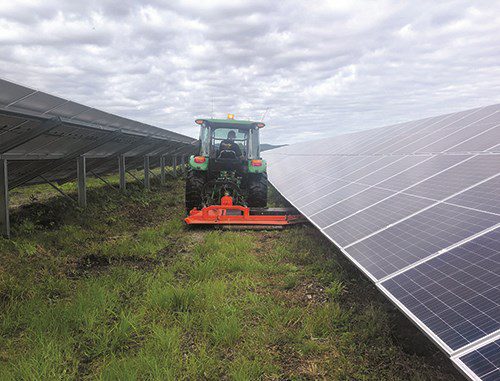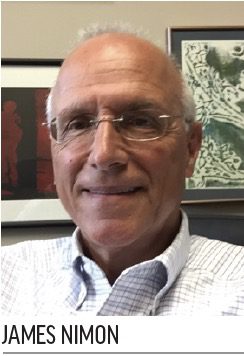A concerted, collaborative effort has turned empty land at Sanford Seacoast Regional Airport (SFM) in rural Maine into a privately financed 50-megawatt solar farm. The $120 million array, which went live in November 2020, is one of the largest airport-based solar energy farms in the United States, as measured by annual megawatt, alternating current (MWac) production.
A concerted, collaborative effort has turned empty land at Sanford Seacoast Regional Airport (SFM) in rural Maine into a privately financed 50-megawatt solar farm. The $120 million array, which went live in November 2020, is one of the largest airport-based solar energy farms in the United States, as measured by annual megawatt, alternating current (MWac) production.
Project officials note that the 50 MWac the new farm can produce is enough to power more than 20,000 homes, and SFM is located in a city of about 21,000 residents. By comparison, Tallahassee International Airport has two solar installations that generate a combined total of 62 MWac, and the solar farms at Indianapolis International generate 17.5 MWac. But the airport solar scene is dynamic: A 120 MWac farm is tentatively slated to open at Edmonton International in Canada late next year.
To be sure, developing and executing a solar project was an ambitious undertaking for SFM, a municipally owned general aviation reliever airport with about 50,000 annual operations. The recently completed farm consists of 177,034 photovoltaic panels—some of which are single axis-rotating to preclude glint and glare from impeding the vision of pilots. The arrays sit in four different areas on 156 acres of airport land and 113 acres of adjacent land. In total, SFM has 1,119 acres at its disposal, and 419 acres are authorized for non-aeronautical use, such as the solar farm. That leaves more than 260 acres available for future expansion of the solar farm or other non-aeronautical development.
|
facts&figures Project: Solar Farm Location: Sanford Seacoast Regional Airport Airport Owner: City of Sanford, ME Capacity of Solar Farm: 50 MWac (enough to power more than 20,000 homes) Timeline: Development started in 2015; construction 2019-2020; online in Nov. 2020 Cost: $120 million, financed by NextEra Energy Farm Owners: NextEra Energy Partners; investor group headed by KKR & Co. Financial Details: City receives $183,000/year for leasing land the solar farm occupies; owners sell energy farm generates to regional utility company; city collects $500,000/year in business property tax revenue, which it pours into local economic development initiatives via a tax increment financing district; city receives $173,000/year for ground maintenance services Environmental Implications: Solar farm offsets 500,000 tons of carbon dioxide emissions annually; conservation easements included in areas that provide habitats for specific wildlife Solar Contractor: Wanzek Substation Contractor: Cianbro Survey & Other Support Services: Stantec Environmental Consultant: TRC Environmental Permitting & Compliance Support: Flycatcher LLC Maintenance: Airport employees manage vegetation & remove snow |
The current solar farm supplies power directly into the regional utility’s grid, and was financed by developer NextEra Energy, based in Florida. NextEra bought the project from initial developer Ranger Solar in 2017, and managed the project through completion. In November 2020, NextEra sold the completed farm to its subsidiary, NextEra Energy Partners, and an investor group headed by KKR & Co. Inc. The farm at SFM was part of a package that included six other solar sites throughout the United States.
Airport Manager Allison Navia explains that the airfield solar farm is a public-private partnership between the city, airport, private developers, regional and local utility companies, and the Sanford Regional Economic Growth Council, which is a local business non-profit entity that helps drive business and investment initiatives in the city of Sanford and Springvale, a village within the city.
When the various entities came together in 2015, the city and airport had an expansive vision to make SFM financially self-sufficient. “Our motivation was to get the airport off the city’s general fund, to create jobs and generate tax revenue,” explains James Nimon, executive director of the Sanford Regional Economic Growth Council.
Mission Accomplished
The project created 94 construction jobs and 10 permanent positions; and the airport is, in fact, now financially self-sufficient. The city, which owns SFM, makes money from the massive undertaking in three ways: $500,000 of annual business property taxes paid by the solar farm’s ownership group; $183,000 per year in lease payments for the airfield and other land the solar farm occupies; and $173,000 per year to maintain the solar farm grounds (snow removal and vegetation management services are provided by two to three airport maintenance workers).
Additionally, the city gained approval from the state to create a tax increment financing district, which funnels tax revenue from the farm directly into economic development projects at the airport. Current infrastructure improvements being supported include the debt service of an Airport Administration, Operations and Maintenance Facility, new hangars, water and sewer system upgrades and the addition of a broadband network. Other improvements already in place include a perimeter fence and a new airport road, as stipulated in the land lease agreement.
 Overall, Navia describes the solar farm as a monumental project. “There was always something cropping up—real estate issues, regulatory complexities, state environmental concerns and technical hurdles,” she explains. Moreover, issues were often interrelated, with response to one challenge creating or revealing additional challenges.
Overall, Navia describes the solar farm as a monumental project. “There was always something cropping up—real estate issues, regulatory complexities, state environmental concerns and technical hurdles,” she explains. Moreover, issues were often interrelated, with response to one challenge creating or revealing additional challenges.
Take real estate, for example. The solar farm had to reach 50 MWac of generating capacity to achieve the necessary economy of scale and justify investment. Navia explains that the initial understanding, even after satisfying some federal environmental permitting requirements, was that airfield acreage could provide enough land. However, the state Department of Inland Fish and Wildlife and the state Department of Environmental Protection required conservation easements for areas of the airfield that provide habitats for various species—especially black racer snakes, Blanding’s turtles and grasshopper sparrows. Researchers needed access to study those and other wildlife present on the airfield.
With the required setbacks around those areas figured into the project design, there was not enough airport land to accommodate the needed amount of solar panels. So the city and developer secured additional acres adjacent to the airfield to make up the shortfall. Some is Sanford Sewerage District land; others are privately owned parcels that NextEra now leases.
Another cascading challenge involved the regional utility, Central Maine Power. During the development phase of the project, it identified the need for a substation to handle the new influx of power the solar farm would produce. The solution: NextEra bought a non-airport parcel of land beside utility power lines and constructed an $8 million substation, which it then transferred to Central Maine Power.
Connecting the solar farm and substation required crews to install cable underneath SFM’s runways, taxiways and roadways via horizontal direct drilling methods—substantial projects that alone took several months and spanned multiple seasons.

Maintenance Matters
The owners of the new solar farm pay the city $173,000 per year to maintain the grounds. Employees at the city-owned airport are responsible for managing vegetation and clearing snow. During project planning, SFM Maintenance Supervisor Joe Ridley and his team jumped into action collecting measurements of the array forms and clearances to determine what kind of equipment they would need.
Based on their research and recommendations, the city purchased a Bobcat skid-steer track loader, a John Deere tractor and two mowers to meet the airfield’s changing maintenance needs. Ridley and his colleagues customized one mower by removing its factory-supplied cover and fashioning a new one that allows the machine to maneuver under the solar panels and around the poles that support them. With revenue earned from fulfilling the solar farm maintenance contract, the new equipment is projected to pay for itself within one year of use.

Looking Back & Ahead
 Figuratively speaking, the solar panels that rotate to mitigate glare were not the project’s only moving parts. Coordinating those parts into a revenue-generating asset was a big win for the small airport. Nimon, from the Sanford Regional Economic Growth Council, says that the substantial accomplishment shows what is possible when the right partners assemble. “This is a new day for Sanford and our region in terms of generating renewable power,” he remarks. “It’s that combination of economics and renewables that is a big flag waving to attract additional investment in the community.”
Figuratively speaking, the solar panels that rotate to mitigate glare were not the project’s only moving parts. Coordinating those parts into a revenue-generating asset was a big win for the small airport. Nimon, from the Sanford Regional Economic Growth Council, says that the substantial accomplishment shows what is possible when the right partners assemble. “This is a new day for Sanford and our region in terms of generating renewable power,” he remarks. “It’s that combination of economics and renewables that is a big flag waving to attract additional investment in the community.”
The airport’s success may also pave the way for other solar projects in the region, adds Nimon.
That said, adding the solar farm was no walk in the park. As airport manager, Navia emphasizes that teamwork was, and continues to be, essential to the success of the sizable project. In particular, she says that it was crucial to include the SFM Maintenance Department early on.
“It’s very important to start the planning process early,” Navia adds, noting that delving into the solar project during a master plan update proved ideal for SFM. “That way, you get all of the players on board at the same time. That’s a huge plus.”
Nimon counsels other airports contemplating a renewable energy project to stay open to partnerships. “Avoid thinking like an island,” he advises. “Start and sustain conversations with developers in the field who understand your organization’s goals.”

In a related vein, Navia notes that it’s vital to ensure that operational efficiency remains the airport’s utmost priority. She knows from experience that this is not easy during an enormous airfield project, but nevertheless believes in the importance of striving to “strike a balance.”
Nimon and Ridley highlight the need to secure support for solar projects from local leaders, and both compliment Navia’s work in that area from start to finish. “You need someone who is unflappable in terms of the things that are going to be thrown at you,” says Nimon.
In retrospect, Navia underscores the need for patience and perseverance. Both were crucial for the SFM team to navigate numerous twists and turns throughout the long initiative. “The project almost died on a monthly basis for about five years,”
she remarks.
Despite the many challenges the project presented, Navia reports that there are already rumblings about expanding the solar farm. Although there is no official timetable, she notes that a decision may be reached about another phase within five years.


